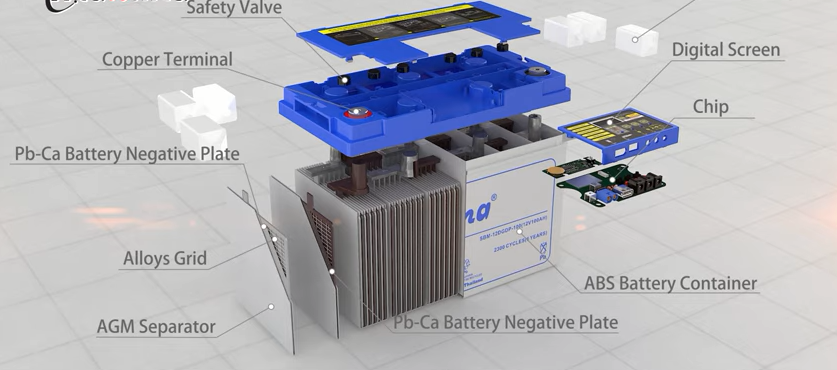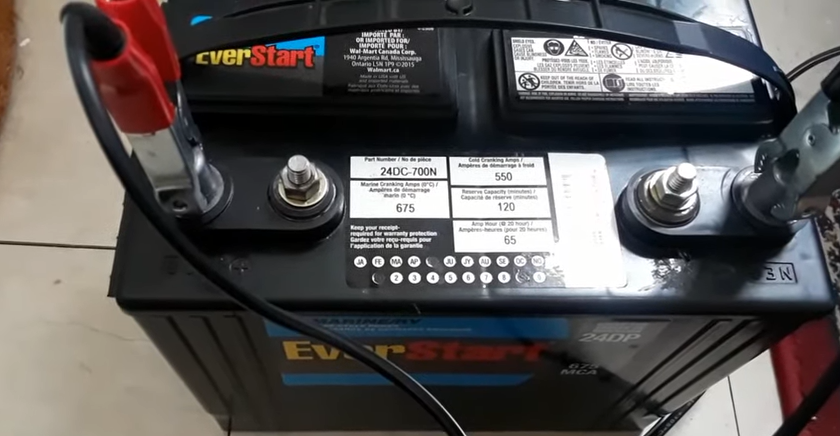Hi, I'm Luis Johnson, an automobile technician, and power equipment professional. By profession, I'm a businessman and operate a car workshop. I have created this...Read more
Batteries have a common nature that diminishes the performance over time, no matter if you use deep cycle batteries. Although the rate of the demeaning of deep cycle batteries is lower than any other batteries, the battery will go bad after a certain period.
So, it is crucial to check your deep cycle battery regularly to ensure the battery is working properly. However, the question is how to tell if a deep cycle battery is bad.
Fortunately, you can tell whether a deep cycle battery is bad by following different methods, including examining the battery physically, taking a voltage reading, and carrying out a load test.
Don’t you figure out how to check your deep cycle battery with these methods? Read the entire guide; here, we’ll discuss step-by-step instructions on these three methods to check your deep cycle battery.
Reasons for A Deep Cycle Battery Go Bad
Several reasons can cause a deep cycle battery to become bad. However, some major reasons causing a bad battery have been illustrated below.

Exceeding Age Limit
Every battery has a specific age limit, including deep-cycle batteries. Most deep cycle batteries typically last around 1,500 cycles, mainly related to the battery’s chemical age. That means when a battery overcomes the cycle, the performance of the battery will decrease.
Too Much Sulfation
Even after having the expected lifespan of a deep cycle battery, it can fail because of over sulfation. Sulfation is mainly known as a chemical issue for batteries. This issue causes forming lead sulfate crystals on the surface of the battery’s lead plates. When this happens, the chemical reactions inside the battery will reduce, causing the plates to lose capacity.
Having Dead Cells
During regular charge and discharge cycles, the plates of a battery expand and contract, causing the plates/grids to shed active materials. Due to shedding active materials, these plates lose their capacity, forming sediment in the cell’s bottom. This process is typically called sludge or mud, which is responsible for the dead cells of a battery.
Experiences Short Circuits
Besides bad cells, loose terminal connections can cause short circuits in a battery. Excessive heat will be produced when a short circuit occurs, as current is released instantly. If a battery encounters an extreme short circuit, there can be melting or burning issues, causing the battery to go bad.
Damage Case, Terminals, or Connectors
Apart from the reasons above, deep cycle batteries can also be damaged by corrosion, mishandling, loss of water, excessive vibration, overcharging, wrong chargers, or negative grid shrinkage.
How To Tell If A Deep Cycle Battery Is Bad? [3 Easy Methods]
For regular users, telling whether a deep cycle battery is bad can be challenging. That’s why here we’ve explained three easy ways to tell if a battery is bad.

Method 1: Inspect Your Battery Physically
Physically inspecting your deep cycle battery is the easiest way to tell whether it is bad. In that case, you’ll just have to examine some signs on the battery, which will help you reveal many things about it. Some signs that you should look out for in your battery include the following:

- Discoloration: Appearance is the factor that tells more about a thing. So, you should check properly whether the color of your battery changes significantly. Typically, batteries will fade in color over time when something happens wrong.
- Loose or Broken Terminals: Lose or broken terminals of a deep cycle battery can be dangerous. This can cause a short circuit, making your connected equipment damaged and even exploding. Besides, corrosion on the battery’s terminal also can cause it to short circuit.
- Leaks: Having fluid leaks on a battery is another sign of having a bad battery. Basically, leaks in a battery lead the plates exposed to oxygen, causing sulfation which will make the battery fail early.
- Exterior Cracks: Cracks, holes, or fluid splits on the deep cycle battery can cause the battery to degrade significantly. So, if you notice any of these signs, it will be better not to use the battery.
Method 2: Measure the Voltage
If you don’t find anything suspicious that can cause the battery to be bad, take a voltage reading. Checking the battery voltage will help you to know whether the battery can hold enough charge.

However, to take a voltage reading of your battery, you’ll need a multimeter, knowledge about voltage readings, and a fully charged battery. Before measuring the voltage of your battery, let’s know the meaning of different voltage readings.
- Voltage Reading 0: Your battery typically encounters a short circuit.
- Voltage Reading Less Than 10.5: The battery is sulfated or has dead cells, causing it can’t hold the charge.
- Voltage Reading 12.2 to 12.6: This voltage range indicates that your battery is in good condition.
See Also: What Causes A Dead Cell In A Car Battery?
How to Use a Multimeter to Measure a Battery?
- Prepare the Multimeter: First, you have to set the multimeter range between 0 and 20 DC voltage. However, if your meter has no incremental options, adjust it to the DC voltage option.
- Touch the Probes to Battery Terminal: Now touch the multimeter probes to the right terminal of your battery. In that case, you have to touch the black probe to the negative terminal and the red probe to the positive terminal.
- Check the Reading: You will notice reading on the multimeter display once you touch the probes to the right terminal. Now compare the voltage reading to the voltage figure discussed above.
Method 3: Perform A Battery Load Test
Besides measuring the battery voltage, you can also take a load test of your deep cycle battery to tell whether it is bad. In that case, you can perform the test on your own or take the help of your nearby automobile service station.

The load test will help you know whether the battery has started failing. For your convenience, below, we’ve pointed out the steps needed to take a load test of a battery.
- First, you’ll need to remove the battery from its terminal and connect it to your load tester.
- Now use a single load to make a circuit. In that case, you have to check the meter’s reading properly. You should connect the cell’s terminals for at least 30 seconds to inspect the voltage behavior closely.
- If the reading is around 9.5 – 10 volts, your battery’s health is good. However, if you find different results on the voltage reading, the battery has a problem.
If you’re still confused about how to check a deep cycle battery capacity through a multimeter and load tester, check the video tutorial:
What to Do With a Bad Deep Cycle Battery?
Depending on the battery condition, you can resurrect a bad deep cycle battery. For example, if your battery has minor issues such as cracks, corrosion, or broken terminals, you can fix them at any battery repair shop. Besides, if the battery has dead cells, you can replace the cells.
However, replacing the battery cells can be expensive. In that case, it will be a wise decision to replace the battery with a new one. You should choose according to the previous battery’s specs when replacing a battery.
How to Look After A Deep Cycle Battery?
Following some simple maintenance measures, you can prolong your deep cycle battery life. Here we’ve discussed some effective tips to prevent the battery from becoming bad.

- Use the Right Capacity Battery: Using a low-performance battery is one of the major reasons the battery becomes bad earlier. For that, you should check your new battery’s capacity to avoid purchasing a low-capacity battery.
- Avoid Charging to 100%: Although it sounds crazy, a high state of charge reduces a battery’s life. Studies found that a 90% charged battery lasts 2–5 times longer than a fully charged one.
- Don’t Discharge to 0%: You should also avoid draining your deep cycle battery completely. This is because discharging a battery completely can lead to metal degradation, causing damage to the battery.
- Inspect the battery Regularly: Examine the battery regularly and fix any issues, such as leakages and damages, to prevent sulfation. You also have to avoid storing the battery below 32 °F (0 °C) and above 95 °F (35 °C).
- Charge the battery Regularly: Keep your battery charged, mainly when unused. This will help to prevent self-discharge of the battery. To fully charge a deep cycle battery, you should regularly charge it for around 4–6 hours.
Frequently Asked Questions
Here are some commonly asked questions with answers about deep cycle batteries. Check the section; you may find the answers helpful.
How Long Does a Deep Cycle Battery Last?
You can expect a deep cycle battery will last around 3–6 years, depending on the battery quality and the frequency of use. In terms of a single charge, a deep cycle battery can provide power for a few hours up to a couple of days, depending on the load.
What are the Types of Deep Cycle Batteries?
You will find different types of deep cycle batteries on the current market. Some common deep cycle battery types are AGM deep-cycle, Gel, Flooded lead-acid, and Lithium deep-cycle batteries.
What Will Happen If I Overcharge My Deep Cycle Battery?
Overcharging a battery can cause it to lose overall capacity over time. This can also impact the lifespan of a battery. So, you should charge a deep cycle battery depending on the manufacturer’s suggestion.
Can A Deep Cycle Battery Have Good Voltage But Still Be Bad?
Yes, a deep cycle battery can show a good voltage rating when checking the voltage but don’t power your loads when you intend to use it. That’s why you should perform a load test after checking the voltage of your deep cycle battery.
Why is My Deep Cycle Battery Not Holding Charge?
Several reasons can cause your deep cycle won’t hold a charge, including older battery age, bad battery connections, low maintenance, and improper maintenance. To prevent this problem, you should keep the battery in proper condition.
Final Thoughts
There is no doubt that deep cycle batteries are the best choice for any application. Whether you have RVs, golf carts, lighting systems, or something else, you can use deep-cycle batteries to power the applications.
However, like traditional batteries, deep cycle batteries’ performance degrades over time. So, it is crucial to have a good idea of how to tell if a deep cycle battery is bad. This will help you take the necessary actions to fix the battery or know when you have to replace it.

Hi, I'm Luis Johnson, an automobile technician, and power equipment professional. By profession, I'm a businessman and operate a car workshop. I have created this site Batteryquery to help people purchase the right battery for their vehicles. The reason behind creating this site is to help my customers purchase the right car battery who often purchase the wrong one due to their lack of knowledge.
More Posts